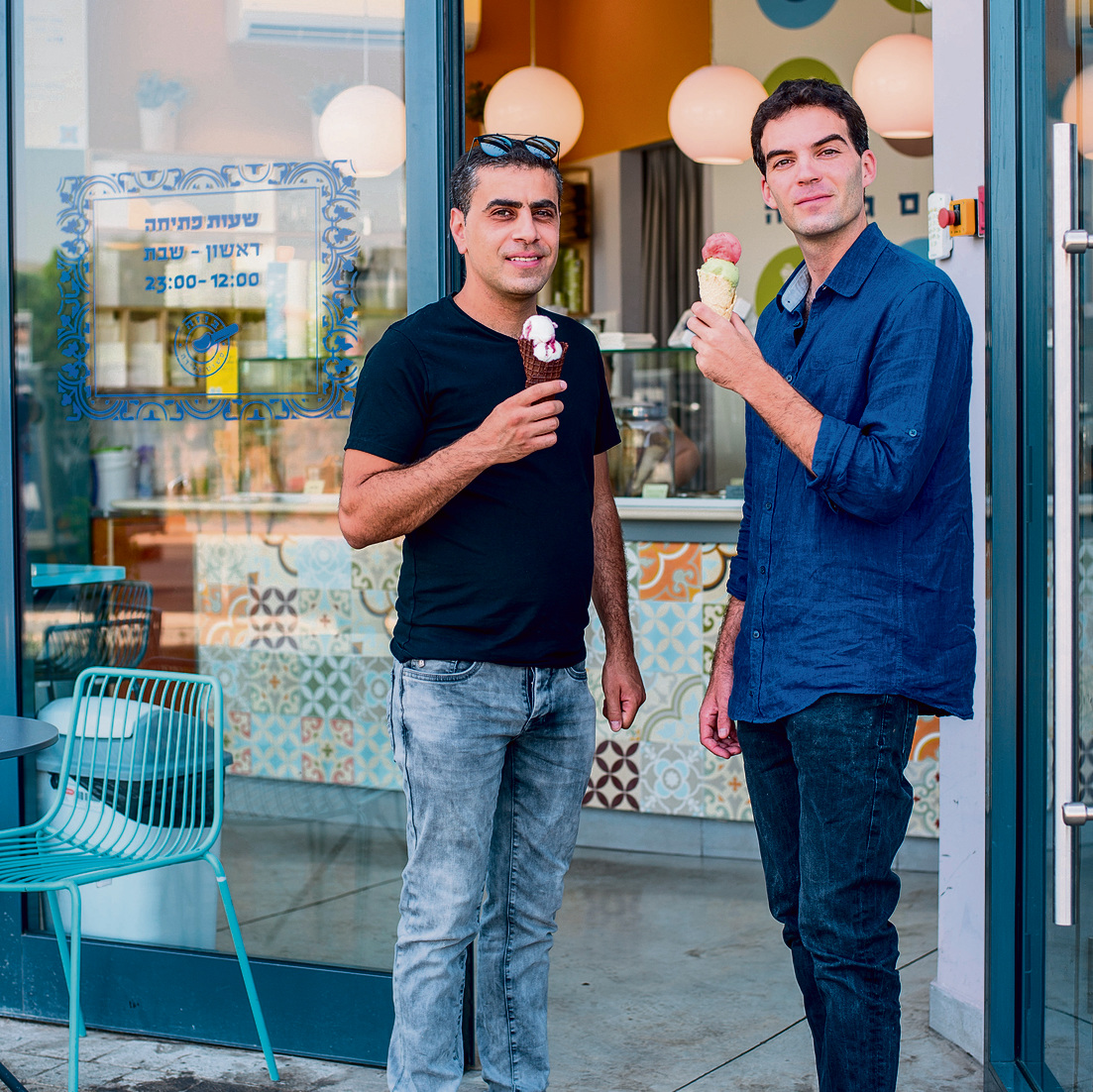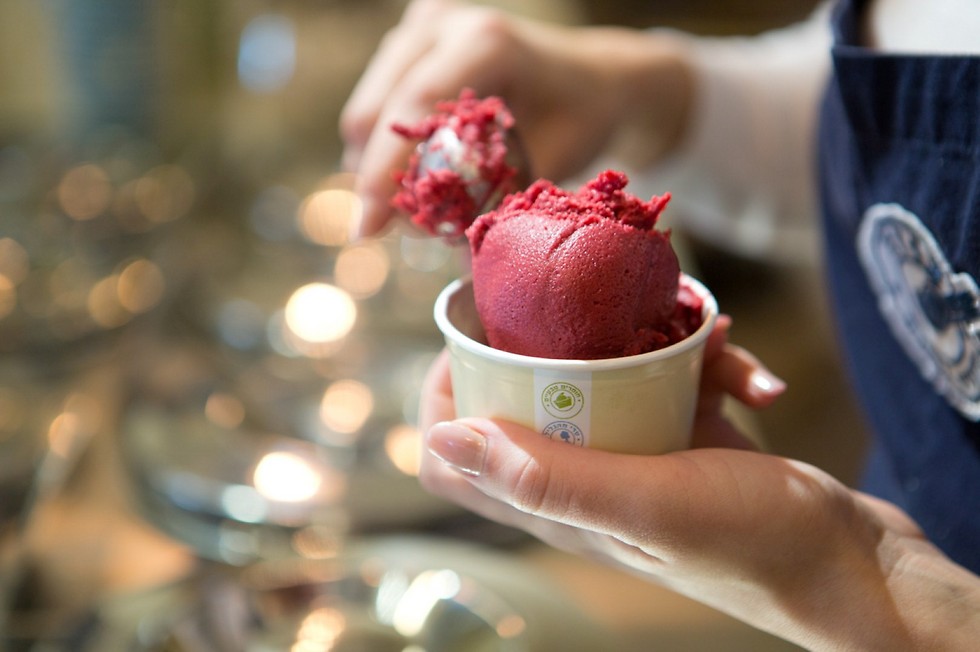

Jewish-Arab ice cream business a sweet symbol of coexistence
Five years after teaming up to produce ice cream, Adam Ziv from Kibbutz Sasa and Alaa Sweitat of Galilee village of Tarshiha are now proud owners of successful chain with five stores in northern Israel and Tel Aviv, becoming first Israeli business to win prestigious UN prize.
“I didn’t even know what caramel was,” he says. “There was no such thing in Kibbutz Sasa, but the name sounded enchanting, and every child was allowed to pick one flavor. So I tried it out, and I fell in love.”
This scoop of ice cream he tasted more than 20 years ago became the first step in a long journey, which recently reached an important milestone: a prize on behalf of the United Nations for helping promote peace. Ziv’s faith in the power of ice cream to bring people closer together apparently convinced the international organization too. It’s what happens when your ice cream is part of a vision of co-existence—a joint Jewish-Arab business.

The prestigious Flourish Prizes were handed out in Cleveland to 17 businesses from all over the world. Ziv, 31, accepted the award together with his business partner over the past five years, 34-year-old Alaa Sweitat, who was born in the Galilee village of Tarshiha and is the owner and chef of the Aluma restaurant.
Unlike Ziv, Sweitat had never dreamed of owning an ice cream business. He connected, however, to Ziv’s vision and spirit of adventurousness, and Buza (the Arabic word for ice cream) was born—ice cream that is produced from the finest products and sold in five locations in northern Israel and in Tel Aviv. And regardless of the wonderful taste of this ice cream, it’s the first Israeli business to win a UN prize.
“When I embarked on my post-army trip, I bought a one-way ticket to Milan with a very clear plan: To play music on the streets, to go from one place to another in Europe and to eat ice cream,” Ziv says. “Six months into the trip, my mother told me she had heard about a project in the Canary Islands—an elderly man who had decided to cross the ocean on a raft and was looking for help. I went there to help him build the raft, and every evening I would have ice cream.
“After several visits to the local ice cream parlor, the owner offered to teach me how to make ice cream and suggested I work there in the evenings. I began doing just that and felt I was in heaven: Next to the sea, playing my music in the evening to people around a bonfire, eating fresh ice cream and feeling good. Shortly afterwards, it suddenly dawned on me and I began asking myself, inspired by that elderly man, how I planned to cross my ocean, what should I do and what do I want to do. I realized that my real dream was not to return to Israel and study music and psychology in order to earn a living, but to open an ice cream parlor with an Arab partner, in an Arab village, in a bid to strengthen the connection between the two people.”
That’s kind of naïve, isn’t it?
“Imagine a summer afternoon, Jewish and Arab parents arriving with their children, nice music playing in the background, the air conditioner is on and the sun is pleasant, and there’s of course good ice cream. What happens? They all sit down and lick their ice cream together. Shortly afterwards, the children start running wild and playing together, the parents look at each other and start talking and getting to know each other, and a sort of natural ‘together’ is created.
“That’s the picture I had in my head, and that’s what’s happening in our store in Tarshiha for five years now. Not to mention the ties created between the employees, who suddenly realize that although they’re members of different religions, they have the same iPhones and the same interests and dreams and plans. It’s beautiful.”
‘Alaa prefers sorbet’
To fulfill his dream, Ziv traveled to Italy to learn about ice cream, its preparation methods and the required machinery for the huge project ahead. He was mostly attracted to gelato, ice cream made of milk and a bit of cream, and dreamed about a transparent kitchen which would allow people visiting the ice cream parlor to experience the preparation process and catch a glimpse of the local and fresh raw materials the ice cream is made of. In the display refrigerator, Ziv wanted to cover the deep ice cream trays with stainless steel lids, to store the products in the finest conditions and offer curious people a surprise experience.
Next, he returned to Israel and began touring Galilee villages in search of the perfect location to fulfill his dream. Following a recommendation from acquaintances, he arrived at the Aluma restaurant and met Sweitat. “Alaa thought about it for a moment and told me it was a good idea and that he had a place for us. We visited it together, and since then—for the past five years—it has been our store, in the center of the village.”

Sweitat confirms he didn’t hesitate, although ice cream is not part of the Arab street he grew up on. “It doesn’t exist here. There are no ice cream parlors in the villages, and both personally and professionally, I was raised on gourmet food, on a meticulous kitchen,” he says. “But an enthusiastic person arrive, and I decided I felt like doing something new.”
Officially, Sweitat’s partner in the ice cream business is Kibbutz Sasa, which approved Ziv’s financial plan in a vote, and he finds it completely natural too. “At Aluma, I also began as a worker and was promoted to partner with the restaurant’s Jewish owner until I became its owner myself, so a partnership with Jews is nothing unusual as far as I’m concerned. Moreover, it was clear to me that it would provide added value to the village and to the Galilee. I’m delighted every day when Jewish tourists come here and feel at home, because that’s the reception they get here.”
In Buza, like in any other ice cream parlor, the most popular flavor is of course vanilla. But here people can try out unique flavors, according to the available local raw materials.
“Let’s assume that a friend has a lemon tree that bears a lot of fruit on a certain season and he comes over with a box. We’ll make lemon ice cream,” says Ziv, who is responsible for the ice cream production and preparation. “If there’s suddenly a lot of pecan from Sasa’s fields, we’ll make all kinds of flavors with pecan, or with special honey that someone brought over. We also investigate what is happening in the world in this field and renew our flavors accordingly. We enter collaborations with leading chefs like Yonatan Roshfeld, Meir Adoni and Omer Miller, as well as with commercial companies occasionally.
“Personally, my favorite flavor is the roasted pecan with salt and organic maple and our cashew flavor. Alaa prefers the sorbet, for example with lychee from the Galilee and the sabra fruit.”
An ice cream parlor and an investment fund
Two flavors which have been tried out but did not appeal to the Israeli audience are apple sorbet (“most people didn’t even want to taste it, and those who did said it resembled baby fruit puree”) and white chocolate ice cream with ginger and orange zest (“a flavor I was introduced to in the Canary Islands, where it’s very popular,” Ziv says. “I fell in love with it too, but here people wouldn’t even taste it”). On the other hand, the most popular flavor after vanilla is the chocolate and hazelnut ice cream, which is called “Buza cream.”
Now with five stores—including a visitors’ center offering tours and workshops in Sasa—50 employees and one important prize, their new dream is to raise money and create a foundation to support other joint businesses.
“We’re doing something which we see as a good thing,” says Ziv. “As far as I’m concerned, reality is the connection between people the way it is created in our stores, and I would like to expand the circle, to be able to offer business support, legal counseling and a financial push for businesses with a similar goal, in a bid to change reality on a wider scale.
“The only way to change attitudes is to communicate. In order to light up the darkness, one must turn on a flashlight. The light we are creating with Buza is probably dim, but it’s a light nonetheless. You come to Tarshiha, stop for ice cream and then enter the supermarket, buy something, meet people, understand that you’re not afraid of them and that you don’t have to be afraid of them. It’s a start.”
















